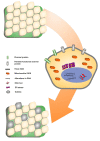REVIEW: Current understanding of the pathogenesis of Fuchs' endothelial corneal dystrophy
- PMID: 31263352
- PMCID: PMC6571125
REVIEW: Current understanding of the pathogenesis of Fuchs' endothelial corneal dystrophy
Abstract
Fuchs' endothelial corneal dystrophy (FECD) is the most prominent reason for corneal-endothelial transplantations across the globe. The disease pathophysiology manifests through a combination of various genetic and non-heritable factors. This review provides a comprehensive list of known genetic players that cause FECD, and discusses the prominent pathological features that participate in disease progression, such as channel dysfunction, abnormal extracellular matrix deposition, RNA toxicity, oxidative stress, and apoptosis. Although current practices to correct visual acuity involve surgical intervention, this review also discusses the scope of various non-surgical therapeutics to remedy FECD.
Figures

References
-
- Magovern M, Beauchamp GR, McTigue JW, Fine BS, Baumiller RC. Inheritance of Fuchs’ combined dystrophy. Ophthalmology. 1979;86:1897–923. - PubMed
-
- Rosenblum P, Stark WJ, Maumenee IH, Hirst LW, Maumenee AE. Hereditary Fuchs’ Dystrophy. Am J Ophthalmol. 1980;90:455–62. - PubMed
-
- Wilson SE, Bourne WM. Fuchs’ dystrophy. Cornea. 1988;7:2–18. - PubMed
-
- Cross HE, Maumenee AE, Cantolino SJ. Inheritance of Fuchs’ endothelial dystrophy. Arch Ophthalmol. 1971;85:268–72. - PubMed
-
- Mustonen RK, McDonald MB, Srivannaboon S, Tan AL, Doubrava MW, Kim CK. In vivo confocal microscopy of Fuchs’ endothelial dystrophy. Cornea. 1998;17:493–503. - PubMed
Publication types
MeSH terms
LinkOut - more resources
Full Text Sources

